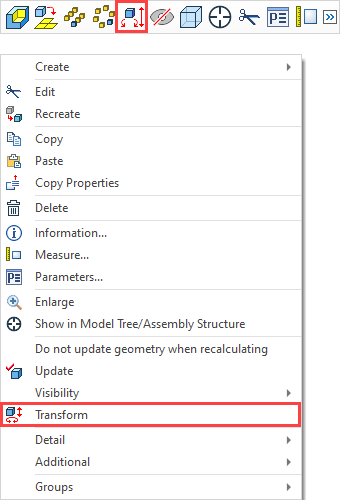Transformations of 3D Elements |
  
|
The command can be called in one of the following ways:
Icon |
Ribbon |
|---|---|
|
3D Model > Additional > Transformations Assembly (3D) > Additional > Transformations Sheet Metal (3D) > Additional > Transformations Surfaces > Additional > Transformations Weld > Additional > Transformations Routing > Additional > Transformations Primitives > Additional > Transformations Support Geometry > Additional > Transformations |
Keyboard |
Textual Menu |
<3EG> |
Tools > Transformations |
The command can also be called from the contextual menu for a selected operation in the command standby mode:

The command serves for translating, rotating, scaling and mirroring operations and 3D constructions. Transformation parameters are recorded in the parameters of 3D elements. Moreover, parameters of operation (or the element of 3D construction) can contain simultaneously several transformations that are executed successively one after another. It is also possible to form a group of objects and create common transformations for them.
Apart from using this command transformations can also be applied in other ways:
•Upon Primitives creation;
•Upon inserting 3D Fragment into an assembly;
•Directly in the Transformations tab of the object Parameters dialog.
Beside main transformations there are special Mate Transformations.
Transformations are most commonly used for positioning fragments in assemblies. However you can also use transformations on objects inside a single part.
Upon calling the Transformations command the Parameters window contain two tabs - Objects and Transformations. Upon selecting an object of transformation three more tabs become available: Main Transformations, Scaling (if applicable to selected object) and Mate Transformations (if there are mate transformations applied to selected object).
Upon calling the command and selecting an object, all transformations previously applied (in any way) to this object are displayed in the Parameters window.
Topics in this section:
•Selecting 3D Elements for Transformations
•Source and Target LCS of 3D Transformations
•Defining Source LCS of 3D Transformations
•Source LCS Manipulators of 3D Transformations
•Adaptive 3D Fragments Transformations Specifics
•Example of 3D Transformations Usage
•Applying 3D Transformations to Group of Elements
See Also: